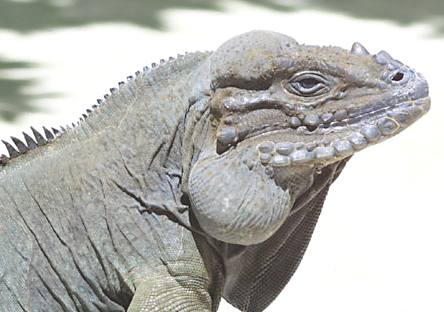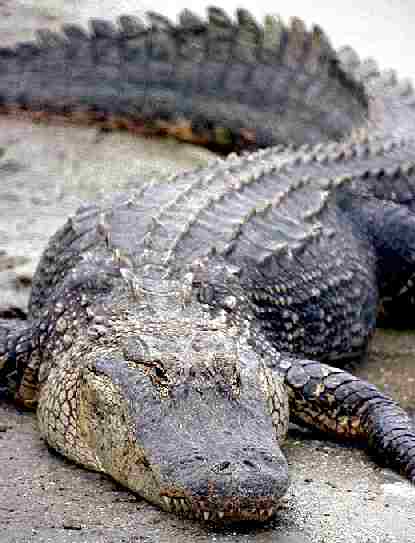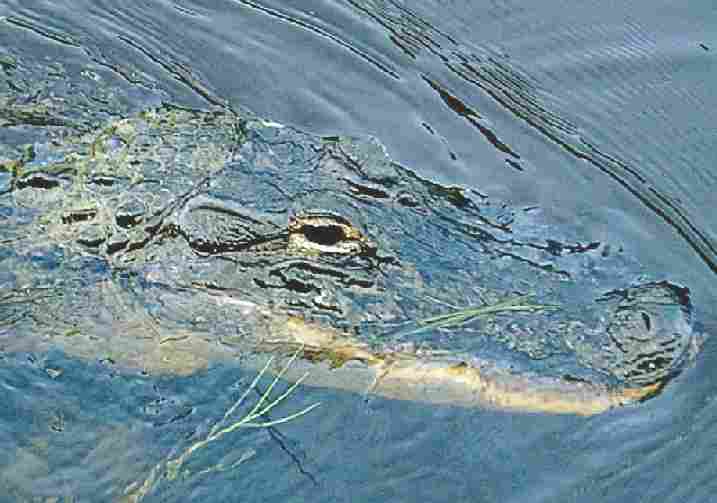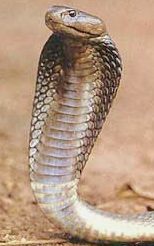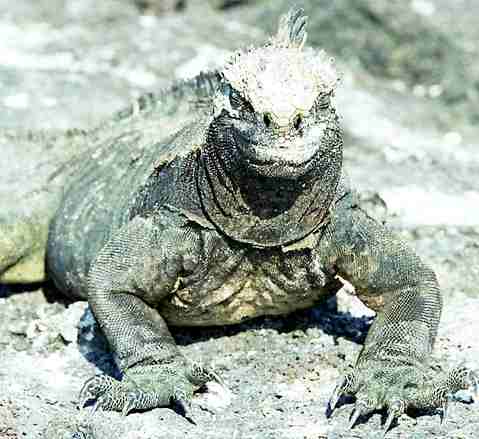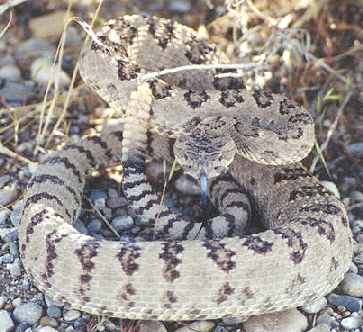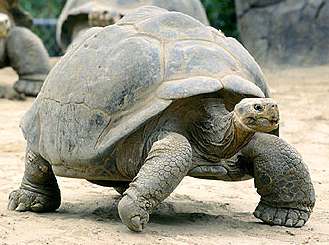|
REPTILES
|
||||||||||||||||||||||||||||||||||||||||||||||||||
|
HOME | BIOLOGY | BOOKS | FILMS | GEOGRAPHY | HISTORY | INDEX | INVESTORS | MUSIC | NEWS | SOLAR BOATS | SPORT |
||||||||||||||||||||||||||||||||||||||||||||||||||
It's sad to think that one day, the planet Earth may be gone. This is despite our best efforts to save her. The good news is that provided we all work together, we can preserve the status quo on our beautiful blue world, for centuries to come. Provided that is we heed the warnings nature is sending us, such as global warming and other pollutions.
Let the animals enjoy the Earth
A reptile is an animal with tough, dry skin covered with horny scales. They are some of the most fascinating animals on Earth and some of my favorites. Some of the most widespread living reptiles are turtles, lizards, snakes, crocodiles, and alligators. Reptiles are vertebrates - animals that have a backbone. While they share characteristics common to other vertebrates: fish, amphibians, birds, and mammals, reptiles display a unique combination of characteristics that distinguishes them from other vertebrates.
Like amphibians, modern reptiles are cold-blooded, or ectothermic. This means that they are unable to produce their own body heat, so they rely on the sun for warmth, and much of their behavior is directed toward regulating their body temperature. Like birds, most reptiles hatch from eggs that are laid on land, covered by a protective shell. Reptiles breathe air with lungs, as do most mature amphibians and all birds and mammals. And like amphibians and mammals, most reptiles, with the exception of turtles, have teeth. Reptile skin, with its tough, horny scales, is unique in the animal world. It is neither moist and permeable, like that of amphibians, nor feathered, like that of birds, nor covered with hair, like that of mammals. Reptiles inhabit nearly every corner of the planet, including most of the world’s oceans. They are found in a broad range of habitats, from the bottom of ponds and lakes to the tree lines of high-elevation alpine regions. However, they are especially abundant and diverse in the tropics and in deserts. The single factor that limits their geographic distribution is their inability to generate their own body heat. For this reason, no reptiles are found in icy Antarctica or the polar oceans, and few live within the Arctic Circle.
Rhinoceros Iguana
DIVERSIFICATION
TURTLES and TORTOISES
All reptiles with a protective shell are turtles, and there are over 250 species of turtles and tortoises worldwide. In North America, people use the word tortoise to designate those turtles that live entirely on land, and the word terrapin for the diamond-backed terrapin of brackish coastal marshes. Turtles and tortoises range in size from the tiny American bog turtle, which reaches just 11 cm (4.3 in), to the giant leatherback sea turtle, which has a shell up to 2.4 m (8 ft) long and can weigh over 900 kg (2,000 lb).
A turtle’s shell is formed from flat bones fused with parts of the spinal column and the ribs. In most turtles, the shell bones are covered with broad scales called scutes. Turtles that live all or part of their lives on land tend to have strong, heavy shells, while those that spend nearly all of their time in water may have lighter, flatter shells. For example, the gopher tortoise of the southeastern United States has a hard, high-domed shell. In contrast, the soft-shelled turtles of freshwater lakes and rivers have flat, rubbery shells that are covered by leathery skin instead of scutes. These turtles spend much of their time hidden in mud in shallow water.
Gopher tortoise
LIZARDS
With over 4,300 individual species, the lizards are the most abundant and diverse group of reptiles alive today. Typical lizards have long, slender bodies that taper to a narrow, pointed tail. Most have four legs ending in dexterous, clawed toes, although several types of lizards, including some worm lizards, have reduced limbs or no limbs at all. Typically, lizards are between 10 and 20 cm (4 and 8 in) long, but some, such as the tiny Monito gecko, grow to only about 3.5 cm (about 1.5 in) and weigh only 0.1 g (less than 0.01 oz). The largest lizard is the Komodo dragon, a giant monitor lizard of Southeast Asia, which reaches 3 m (nearly 10 ft) in length and weighs up to 165 kg (about 365 lb).
Most lizards are small, agile insectivores that live in trees or shrubs or in rocky places. Larger lizards may eat other vertebrates, and a few species are herbivores, or plant eaters. The Galápagos marine iguanas are the only lizards that regularly venture into the ocean. These lizards feed mostly on algae that they scrape from underwater rocks with their claws and teeth. Only two lizard species—the gila monster and the beaded lizard—produce venom, although the bite of the Komodo dragon can sometimes be fatal because infectious bacteria are present in its saliva.
SNAKES
Closely related to lizards are snakes, a group of more than 2,500 species of limbless reptiles. Most snakes are 25 to 150 cm (about 10 to 60 in) long, but some are smaller, such as the West Indian thread snake, which reaches just 13 cm (5 in) at maturity. The largest snake may be the anaconda, a South American member of the boa family, which grows to a length of 10 m (about 33 ft) and weighs up to 250 kg (about 550 lb). Snakes evolved from lizards, possibly from those that burrowed in the ground, or from species that were adapting to an aquatic life. Unlike most lizards, which are equipped with moveable eyelids and external, tiny ears, snakes have no external ears, and their eyes are protected by fixed, transparent scales.
Snakes live in nearly every habitat imaginable, from forests and lakeshores to prairies and deserts, and on every continent except Antarctica. Sea snakes have flattened tails to propel themselves through tropical ocean waters. Many snakes, from the American rat snakes to many boas and pythons, climb and live much of their lives in trees.
Most snakes are harmless to humans. Nevertheless, at least three snake families have evolved venom and specialized teeth called fangs that deliver these toxic secretions into prey animals and potential predators, including humans. The vipers, a family that includes the rattlesnake, have long fangs that fold up when the mouth is closed. Members of a family made up of cobras and their relatives typically have short fangs that do not fold. A large group of mostly harmless snakes called the colubrids includes a small number of extremely venomous species with fangs in the back of their mouths. One such snake is the African boomslang.
Lazy Croc
CROCODILIANS
Crocodilians, which include crocodiles, alligators, caimans, and gavials, are typically 2 to 4 m (6 to 13 ft) long, but some species grow much larger. The formidable saltwater crocodile grows up to 10 m (33 ft) long and can weigh more than a ton. Crocodiles and their relatives live mostly in the warm tropical parts of the world, although alligators range into more temperate climates in the southern United States and China. Crocodilians spend most of their time in the water, where they swim with graceful strokes of their strong, flattened tails. Their eyes and nostrils are located on top of their heads, enabling them to see and breathe while the rest of the body is submerged. With only their eyes and nostrils showing, they glide stealthily through the water, escaping notice by prey.
Physical Characteristics
Like all vertebrates, reptiles have a central nervous system and a well-developed brain. Most have two lungs, although many snakes have lost their left lungs over the course of evolution. All reptiles but crocodiles and their relatives have three-chambered hearts. In the crocodile group, the heart has four chambers, like the hearts of mammals and birds. The reptile digestive system is much like that of other vertebrates, but in reptiles, the gut and the ducts of the urinary and sexual organs empty into a posterior chamber called the cloaca. In many reptiles, particularly those inhabiting hot, arid environments, wastes from the kidneys are passed to the cloaca, where water is absorbed back into the body for reuse. The remaining wastes leave the body through a muscular opening in the cloaca, located at the base of the tail.
The characteristic dry, scaly skin protects reptiles’ internal tissues from drying out, and in many species it also plays a role in defense and mating. The outer layer of reptile skin, called the epidermis, is composed of a horny material called keratin. A reptile’s scales are not separate, detachable structures like fish scales, but rather thickenings of the epidermis. The lower layer of skin, called the dermis, contains many blood vessels and nerves as well as the pigment cells that give reptiles their color.
A nearly invisible Crocodile
Most reptiles are drab shades of green, brown, and gray, presumably to blend well with their surroundings. However, many turtles, lizards, and snakes feature brilliant markings of blue, green, yellow, orange, and even purple. Some reptiles, notably chameleons and anolis lizards, are able to change the color of their skin, alternating between drab and vibrant colors by dispersing or concentrating specialized pigment cells called melanophores. Color changes may enable reptiles to escape notice by predators by blending with their environment, but these color changes may be more important in communicating with other reptiles, for instance, to attract a mate or warn a rival. As they grow, reptiles regularly molt, or shed their outer layer of skin. This layer may be sloughed off in large flakes, but snakes and worm lizards often shed their skin in a single piece.
Reptiles rely on their keen senses to find food and evade predators. Among species that hunt for food, the eyes are often located at the front of the head to provide binocular vision, the ability to see objects from slightly different angles to create a sense of depth. Many lizards, such as chameleons, can move their two eyes independently of one another to look in different directions at the same time. In some lizards and all snakes, a transparent scale, called a spectacle, covers each eye, providing a protective covering that keeps dust out and moisture in. Reptiles with spectacles do not have eyelids that open and close, giving the eerie impression that these animals stare relentlessly.
Reptiles taste and smell using an organ in the roof of the mouth called the Jacobson’s organ—a small cavity lined with sense detectors that recognize chemical changes in and around the mouth. This sense organ helps the animal locate prey, find mates, and generally obtain information about its surroundings. Monitor lizards and snakes continually flick their forked tongues, collecting small airborne particles that are carried back to the Jacobson's organ. The information they obtain in this way enables them to detect prey and follow scent trails. Pythons, boas, and pit vipers find prey using sensory pits in their heads that detect the body heat given off by prey. Using this extraordinary heat-seeking ability, pit vipers can even track down and kill prey animals in utter darkness.
King Cobra
REPTILE BEHAVIOUR
Although reptiles are cold-blooded, the body temperature of most terrestrial reptiles matches the temperature of their environment only at night and during periods of inactivity. During the day, these reptiles are able to maintain their body temperatures within a very narrow range, often warmer than their surroundings, and much of their behavior is geared toward manipulating the heat flow between their bodies and their environment. Reptiles bask in the sun during the morning, often on an exposed rock, log, or branch. They may darken their skin to increase absorption of sunlight—the darker pigment molecules absorb radiant heat more readily than do those of lighter colors. Or, they may flatten their bodies to increase the area exposed to the sun.
If a reptile’s head and brain become uncomfortably hot before the rest of its body is warm enough for activity, the reptile may open its mouth into a gape, enabling moisture inside the mouth to evaporate to create a cooling effect. This behavior is commonly seen in crocodiles. Some desert lizards may pant, much like dogs, to lose heat by evaporating water from their mouths. Lizards and snakes may shuttle between warm and cool places, including different positions within trees. Semiaquatic turtles and crocodiles may move between land and water, and aquatic reptiles may travel between warmer and cooler parts of the water.
When the weather cools, many reptiles find a secure place underground or in ground debris, where they pass the winter in a state of torpor, or inactivity much like hibernation. Turtles may retreat to the bottom of ponds, where they remain even when the ponds ice over. They are able to absorb all the oxygen they need from the water through the linings of their mouths and throats, their skin, and thin-walled sacks called bursae in their cloacae. When the weather warms in the spring, reptiles emerge again to begin a new season of activity and reproduction.
DIET
Many reptiles and all snakes are carnivores, or meat eaters. A majority of lizards eat insects, while most snakes eat smaller vertebrates, including birds, rodents, fish, amphibians, and other reptiles. For many snakes, bird and reptile eggs are a tasty delicacy. Many turtles and tortoises, as well as some lizards including the common green iguana, are herbivores, or plant eaters, and obtain their food by browsing leaves and fruits. Other turtles, such as the American painted turtles and sliders, are omnivores—animals that eat both plants and animals.
Carnivorous reptiles vary greatly in their means of securing prey. Some aquatic turtles ambush prey with a rapid thrust of their long necks while drawing water into their mouths to suck in the prey. Many smaller snakes, such as rat snakes and kingsnakes as well as large snakes like pythons and boas, strike and grasp their prey, throwing coils of their body around it to kill it by suffocation before swallowing it whole. Nearly all snakes can dislocate their jaws to swallow prey far larger than their own heads. Although it is unusual, African pythons have been observed eating impalas, small antelopes that stand about 1 m (about 3.3 ft) tall.
Venomous snakes strike out and bite their prey, injecting them with venom. Instead of struggling with the prey as the venom takes effect, these snakes often release the doomed animals. They then use their tongue and Jacobson’s organ to track their dying prey. Chameleons have long sticky tongues that they project with remarkable accuracy and speed to zap up unsuspecting insects. Large monitor lizards can stalk prey animals, but they often feed on carrion, the bodies of dead animals. Crocodiles mostly eat fish, but they can also use stealth and the cover of water to bring down large mammals, such as deer or cows drinking from the banks of a river or lake.
Marine Iguana - Galapagos Islands
REPRODUCTION
Most reptiles display elaborate courtship rituals. Lizard courtship is often accompanied by changes in coloration. For example, male chameleons undergo color changes during courtship, and pregnant females display vibrant coloration to indicate that they are not receptive to mating. Male anolis lizards inflate their dewlaps to impress females and intimidate rivals. A male turtle may court a female by bobbing his head or stroking the female’s face with the claws of his forelimbs. Male tuataras walk in slow circles around a female until she either disappears into a burrow or permits the male to mate with her. Female snakes attract male partners by emitting chemical scents called pheromones. When he locates a receptive female, a male snake courts her by crawling over her repeatedly, then bringing his tail in line with hers so that mating can occur.
Reptile fertilization is internal: the female’s eggs are fertilized by the male’s sperm inside the female’s body. Male turtles and crocodiles have a single penis, but male lizards and snakes have two penises, called hemepenes, which are covered with folds and spines that hold the penis in place during mating. These animals use only one of their hemepenes each time they mate. In species that mate more than once in succession, the males alternate hemepenes. Male tuataras do not have a penis; instead they use the muscular opening of the cloaca to deliver sperm to the female.
Some lizards and snakes give birth to live young, but all other reptiles lay eggs with shells. Reptile eggs are self-sufficient packages containing yolk and protein, which provide the developing embryo with the water and nutrients it requires. These eggs are encased in a hard or leathery shell that protects the embryo from drying out or being attacked by bacteria, while still allowing the exchange of oxygen and carbon dioxide.
The number of eggs or young produced by reptiles varies greatly between species and even within the same species. For example, some of the smaller African tortoises lay only one or two eggs at a time, while at the other extreme, some sea turtles lay up to 150 eggs several times each season. American garter snakes may give birth to litters ranging from 3 to nearly 100 young.
Reptiles typically deposit their eggs in a nest constructed in the sand, soil, or leaf litter, and then leave them unattended to hatch on their own. Exceptions include pythons, which coil around their eggs to protect them from predators. As they coil around the eggs, pythons even accelerate the development of the embryo inside by repeatedly contracting their muscles to generate heat in a process analogous to human shivering. Crocodile mothers, and sometimes fathers, guard their nests. If a young crocodile has trouble getting out of its egg, its parent may assist by picking up the egg in its mouth and gently cracking the shell, without harming the hatchling inside.
EVOLUTION
All reptiles are fully developed and ready for an independent existence when they hatch. But baby reptiles—particularly baby sea turtles—face nearly insurmountable odds in the early months of their lives. These young animals are the favorite prey of many birds, snakes, mammals, and even—in the case of sea turtles—sharks. Relatively few reptiles survive their first year of life. Of those that do survive to maturity, many have extremely long life spans. Some turtles, for instance, are thought to survive up to 120 years in the wild, and the tuatara is probably equally long-lived. Alligators can live over 70 years. On the other hand, some of the smaller lizards may live only four or five years.
A rattlesnake ready to strike
Fossil studies suggest that reptiles evolved from their amphibian ancestors in the early Carboniferous Period, about 340 million years ago. Reptiles surpassed amphibians as the dominant vertebrates on land because they possessed several survival advantages. These include a strong but flexible skeleton; a dry, scaly skin covering that seals in moisture; and eggs with protective shells that enable embryos to develop on land without drying out. These advantages helped reptiles move into habitats where the water-breeding amphibians could not survive.
By the late Carboniferous Period, about 300 million years ago, reptiles had split into several distinct types, characterized by differences in their skulls and skeletons. The Anapsida, of which the turtles may be the only living members, retained some similarities to the earliest reptiles. The Synapsida are sometimes called the mammal-like reptiles, partly because one branch of synapsids evolved into the true mammals. The Diapsida split into two distinct groups: the archosaurs, meaning “ruling reptiles,” which includes the crocodilians, pterosaurs, dinosaurs, and birds; and the lepidosaurs, which gave rise to the tuatara and its extinct relatives, as well as lizards, snakes, and worm lizards.
The Mesozoic Era (240 million to 65 million years ago) is often called the age of reptiles because this era witnessed the dominance of the dinosaurs on land, the plesiosaurs and ichthyosaurs in the sea, and the pterosaurs, or flying reptiles, in the skies. Although these animals are often called reptiles, some of them may have differed significantly from modern reptiles. Recent fossil discoveries suggest that some dinosaurs more closely resembled birds; these dinosaurs had light, hollow bones, and they may have been warm-blooded and covered with feathers. Some scientists believe that these dinosaurs may have been the direct ancestors of birds.
The earliest turtles, lizards, snakes, and crocodiles and their relatives evolved by the middle of the Mesozoic Era. These animals survived the disasters that killed off the dinosaurs and many other creatures 65 million years ago. The reasons for this massive extinction are still being studied, but some scientists have found evidence that a giant asteroid or comet hit the Earth, possibly causing abrupt climate changes that the dinosaurs could not survive.
POPULAR REPTILES:
Giant Tortoise - Galapagos Islands
Please use the Index below to navigate the Animal Kingdom:-
A taste for adventure capitalists
Solar Cola - a healthier alternative
|

